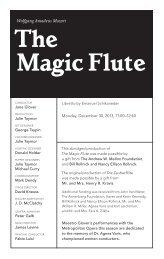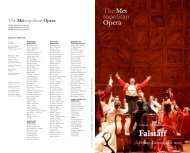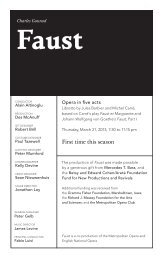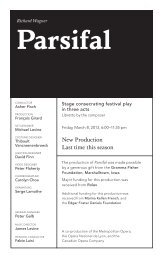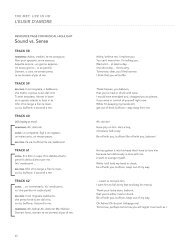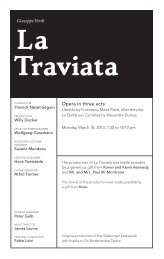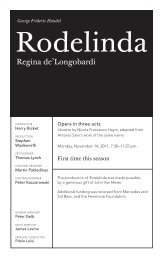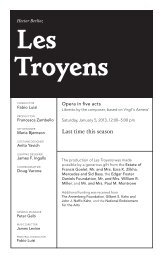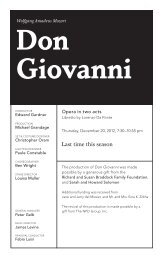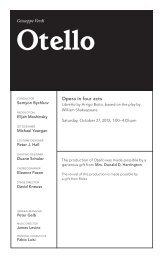Performance Playbill - Metropolitan Opera
Performance Playbill - Metropolitan Opera
Performance Playbill - Metropolitan Opera
Create successful ePaper yourself
Turn your PDF publications into a flip-book with our unique Google optimized e-Paper software.
Giuseppe Verdi<br />
La<br />
Traviata<br />
CONDUCTOR<br />
Fabio Luisi<br />
PRODUCTION<br />
Willy Decker<br />
SET & COSTUME DESIGNER<br />
Wolfgang Gussmann<br />
<strong>Opera</strong> in three acts<br />
Libretto by Francesco Maria Piave, after the play<br />
La Dame aux Camélias by Alexandre Dumas<br />
Saturday, April 14, 2012, 1:00–3:35 pm<br />
ASSOCIATE COSTUME<br />
DESIGNER<br />
Susana Mendoza<br />
LIGHTING DESIGNER<br />
Hans Toelstede<br />
CHOREOGRAPHER<br />
Athol Farmer<br />
The production of La Traviata was made possible<br />
by a generous gift from Karen and Kevin Kennedy,<br />
and Mr. and Mrs. Paul M. Montrone.<br />
The revival of this production was made possible by<br />
a gift from The Dr. M. Lee Pearce Foundation.<br />
GENERAL MANAGER<br />
Peter Gelb<br />
MUSIC DIRECTOR<br />
James Levine<br />
PRINCIPAL CONDUCTOR<br />
Fabio Luisi<br />
Original production of the Salzburger Festspiele;<br />
with thanks to De Nederlandse <strong>Opera</strong>
2011–12 Season<br />
The 972nd <strong>Metropolitan</strong> <strong>Opera</strong> performance of<br />
Giuseppe Verdi’s<br />
La Traviata<br />
This performance<br />
is being<br />
broadcast<br />
live over The<br />
Toll Brothers–<br />
<strong>Metropolitan</strong><br />
<strong>Opera</strong><br />
International<br />
Radio Network,<br />
sponsored by<br />
Toll Brothers,<br />
America’s luxury<br />
homebuilder ® ,<br />
with generous<br />
long-term<br />
support from<br />
The Annenberg<br />
Foundation, the<br />
Vincent A. Stabile<br />
Endowment for<br />
Broadcast Media,<br />
and contributions<br />
from listeners<br />
worldwide.<br />
This performance<br />
is also being<br />
broadcast live on<br />
<strong>Metropolitan</strong> <strong>Opera</strong><br />
Radio on SiriusXM<br />
channel 74.<br />
Conductor<br />
Fabio Luisi<br />
in order of appearance<br />
Doctor Grenvil<br />
Luigi Roni<br />
Violetta Valéry<br />
Natalie Dessay<br />
Marquis d’Obigny<br />
Kyle Pfortmiller<br />
Flora Bervoix<br />
Patricia Risley<br />
Baron Douphol<br />
Jason Stearns<br />
Gastone, Vicomte<br />
de Letorières<br />
Scott Scully<br />
A gentleman<br />
Peter Volpe<br />
Alfredo Germont<br />
Matthew Polenzani<br />
Annina, Violetta’s<br />
companion<br />
Maria Zifchak<br />
Giorgio Germont,<br />
Alfredo’s father<br />
Dmitri Hvorostovsky<br />
Giuseppe, Violetta’s<br />
servant<br />
Juhwan Lee<br />
A messenger<br />
Joseph Turi<br />
A guest<br />
Athol Farmer<br />
Saturday, April 14, 2012, 1:00–3:35 pm
This afternoon’s performance is being transmitted<br />
live in high definition to movie theaters worldwide.<br />
The Met: Live in HD series is made possible by a generous grant<br />
from its founding sponsor, the Neubauer Family Foundation.<br />
Bloomberg is the global corporate sponsor of The Met: Live in HD.<br />
Ken Howard/<strong>Metropolitan</strong> <strong>Opera</strong><br />
A scene from Verdi’s<br />
La Traviata<br />
Chorus Master Donald Palumbo<br />
Musical Preparation Jane Klaviter, Dan Saunders,<br />
Bradley Moore, J. David Jackson, and Steven White<br />
Assistant Stage Directors Gina Lapinski and<br />
Jonathon Loy<br />
Stage Band Conductor Gregory Buchalter<br />
Italian Coach Gildo Di Nunzio<br />
Prompter Jane Klaviter<br />
Met Titles Sonya Friedman<br />
Assistant to the set designer Thomas Bruner<br />
Scenery, properties, and electrical props constructed<br />
and painted in <strong>Metropolitan</strong> <strong>Opera</strong> Shops<br />
Costumes executed by Das Gewand, Düsseldorf and<br />
<strong>Metropolitan</strong> <strong>Opera</strong> Costume Department<br />
Wigs executed by <strong>Metropolitan</strong> <strong>Opera</strong> Wig<br />
Department<br />
This performance is made possible in part by public funds<br />
from the New York State Council on the Arts.<br />
Before the performance begins, please switch off cell<br />
phones and other electronic devices.<br />
Yamaha is the official<br />
piano of the <strong>Metropolitan</strong><br />
<strong>Opera</strong>.<br />
Latecomers will not be<br />
admitted during the<br />
performance.<br />
Visit metopera.org<br />
Met Titles<br />
To activate Met Titles, press the red button to the right of<br />
the screen in front of your seat. To turn off the display, press<br />
the red button once again. If you have questions please ask<br />
an usher at intermission.
Synopsis<br />
There will be one intermission following Act I at approximately 1:30 pm.<br />
Act I<br />
Violetta Valéry knows that she will die soon, exhausted by her restless life as<br />
a courtesan. At a party she is introduced to Alfredo Germont, who has been<br />
fascinated by her for a long time. Rumor has it that he has been enquiring<br />
after her health every day. The guests are amused by this seemingly naïve and<br />
emotional attitude, and they ask Alfredo to propose a toast. He celebrates<br />
true love, and Violetta responds in praise of free love. She is touched by his<br />
candid manner and honesty. Suddenly she feels faint, and the guests withdraw.<br />
Only Alfredo remains behind and declares his love. There is no place for such<br />
feelings in her life, Violetta replies. But she gives him a camellia, asking him to<br />
return when the flower has faded. He realizes this means he will see her again<br />
the following day. Alone, Violetta is torn by conflicting emotions—she doesn’t<br />
want to give up her way of life, but at the same time she feels that Alfredo has<br />
awakened her desire to be truly loved.<br />
Act II<br />
Violetta has chosen a life with Alfredo, and they enjoy their love in the country, far<br />
from society. When Alfredo discovers that this is only possible because Violetta<br />
has been selling her property, he immediately leaves for Paris to procure money.<br />
Violetta has received an invitation to a masked ball, but she no longer cares for<br />
such distractions. In Alfredo’s absence, his father, Giorgio Germont, pays her a<br />
visit. He demands that she separate from his son, as their relationship threatens<br />
his daughter’s impending marriage. But over the course of their conversation,<br />
Germont comes to realize that Violetta is not after his son’s money—she is a<br />
woman who loves unselfishly. He appeals to Violetta’s generosity of spirit and<br />
explains that, from a bourgeois point of view, her liaison with Alfredo has no<br />
future. Violetta’s resistance dwindles and she finally agrees to leave Alfredo<br />
forever. Only after her death shall he learn the truth about why she returned to<br />
her old life. She accepts the invitation to the ball and writes a goodbye letter to<br />
her lover. Alfredo returns, and while he is reading the letter, his father appears<br />
to console him. But all the memories of home and a happy family can’t prevent<br />
the furious and jealous Alfredo from seeking revenge for Violetta’s apparent<br />
betrayal.<br />
At the masked ball, news has spread of Violetta and Alfredo’s separation. There<br />
are grotesque dance entertainments, ridiculing the duped lover. Meanwhile,<br />
Violetta and her new lover, Baron Douphol, have arrived. Alfredo and the baron<br />
battle at the gaming table and Alfredo wins a fortune: lucky at cards, unlucky in<br />
love. When everybody has withdrawn, Alfredo confronts Violetta, who claims to<br />
34
e truly in love with the baron. In his rage Alfredo calls the guests as witnesses<br />
and declares that he doesn’t owe Violetta anything. He throws his winnings at<br />
her. Giorgio Germont, who has witnessed the scene, rebukes his son for his<br />
behavior. The baron challenges his rival to a duel.<br />
Act III<br />
Violetta is dying. Her last remaining friend, Doctor Grenvil, knows that she has<br />
only a few more hours to live. Alfredo’s father has written to Violetta, informing<br />
her that his son was not injured in the duel. Full of remorse, Germont has told<br />
his son about Violetta’s sacrifice. Alfredo wants to rejoin her as soon as possible.<br />
Violetta is afraid that he might be too late. The sound of rampant celebrations<br />
are heard outside while Violetta is in mortal agony. But Alfredo does arrive and<br />
the reunion fills her with a final euphoria. Her energy and exuberant joy of life<br />
return. All sorrow and suffering seem to have left her—a final illusion, before<br />
death claims her.<br />
Visit metopera.org 35
In Focus<br />
Giuseppe Verdi<br />
La Traviata<br />
36<br />
Premiere: Venice, Teatro la Fenice, 1853<br />
Verdi’s La Traviata survived a notoriously unsuccessful opening night to<br />
become one of the best-loved operas in the repertoire. Following the<br />
larger-scale dramas of Rigoletto and Il Trovatore, its intimate scope and<br />
subject matter inspired the composer to create some of his most profound<br />
and heartfelt music. The title role of the “fallen woman” has captured the<br />
imaginations of audiences and performers alike with its inexhaustible vocal<br />
and dramatic possibilities—and challenges. Violetta is considered a pinnacle<br />
of the soprano repertoire.<br />
The Creators<br />
Giuseppe Verdi (1813–1901) composed 28 operas during his 60 active years<br />
in the theater, at least half of which are at the core of today’s repertory. His<br />
role in Italy’s cultural and political development has made him an icon in his<br />
native country, and he is cherished the world over for the universality of his art.<br />
Francesco Maria Piave (1810–1876), his librettist for La Traviata, collaborated<br />
with him on ten works, including Rigoletto, La Forza del Destino, and<br />
Macbeth. Alexandre Dumas fils (1824–1895) was the son of the author of The<br />
Three Musketeers. The play La Dame aux Camélias is based on his own novel<br />
of the same name.<br />
The Setting<br />
With La Traviata, Verdi and Piave fashioned an opera from a play set in<br />
contemporary times—an anomaly in the composer’s long career. Dumas’s La<br />
Dame aux Camélias was a meditation on (and reinterpretation of) the author’s<br />
youthful affair with the celebrated prostitute Marie Duplessis, known as a<br />
sophisticated and well-read woman whose charms and tact far surpassed her<br />
station. The play is still staged today in its original form and exists in several<br />
film incarnations, most notably Greta Garbo’s Camille (1936).<br />
The Music<br />
Verdi’s musical-dramatic ability to portray the individual in a marginalized<br />
relationship to society keeps this work on the world’s stages. The vocal and<br />
emotional scope of the title character is enormous: compare the defiant<br />
fireworks in the Act I show-stopper aria “Sempre libera” to the haunting regret
of Act III’s “Addio, del passato.” The dramatic demands continue in Violetta’s<br />
interactions with others, most notably in the extended Act II confrontation with<br />
her lover’s father, Germont. Often cited as the emotional core of La Traviata, it<br />
is one of the most resoundingly truthful scenes in opera. Germont embodies<br />
the double-faced morality of the bourgeoisie, and Violetta’s interactions with<br />
him parallel her precarious dealings with society in general. She begins with<br />
defiance (“Donna son io”), becomes desperate (“Non sapete”), and finishes<br />
defeated (“Dite alla giovine”). It is a vast journey within a single scene.<br />
La Traviata at the Met<br />
La Traviata was performed within a month of the Met’s opening in 1883, but<br />
then was retired during a subsequent all-German period. After returning to the<br />
schedule in 1894, the opera has appeared in all but 15 seasons since. Notable<br />
productions were introduced in 1921, designed by architectural legend Joseph<br />
Urban; 1935, choreographed by George Balanchine; 1957, directed by Tyrone<br />
Guthrie; and 1966, directed by Alfred Lunt. The two most recent stagings (1989<br />
and 1998) were both directed by Franco Zeffirelli. The roster of Violettas at the<br />
Met reads like a who’s who of the art of the soprano: the great Licia Albanese<br />
holds the record for most performances of the role at the Met (87), followed by<br />
American beauty Anna Moffo (80) and Spanish femme fatale Lucrezia Bori (58).<br />
Renée Fleming and Angela Gheorghiu have been among the notable recent<br />
interpreters of this timeless role. The current production had its premiere on<br />
New Year’s Eve 2010 with Marina Poplavskaya as Violetta.<br />
Visit metopera.org 37
2012 –13 Season
Program Note<br />
Venice I’m doing La Dame aux Camélias, which will probably be<br />
called La Traviata (‘The Fallen Woman’),” wrote Giuseppe Verdi to his<br />
“For<br />
friend Cesare de Sanctis on January 1, 1853. “A subject for our own<br />
age. Another composer wouldn’t have done it because of the costumes, the<br />
period, and a thousand other silly scruples. But I’m writing it with the greatest<br />
of pleasure.”<br />
Despite the palpable conviction in these words, the subject matter of his<br />
18th opera was—typically for Verdi—decided with difficulty. In April of 1852 he<br />
had accepted his fourth commission from Venice’s La Fenice for an opera to<br />
be presented during carnival season the following year. The librettist would be<br />
Francesco Maria Piave, whose collaboration with Verdi had begun with Ernani<br />
(1844), blossomed in Macbeth (1847) and Rigoletto (1851), and would later yield<br />
such fruits as Simon Boccanegra (1857) and La Forza del Destino (1862). As<br />
the search for a scenario dragged on well into autumn of 1852 and as Verdi<br />
rejected suggestion after suggestion from friends and associates, the nervous<br />
theater management dispatched Piave to visit Verdi at his new home in Sant’<br />
Agata to speed up the process. “It was the same story as Ernani all over again,”<br />
Piave reported to La Fenice’s secretary in November about an unknown subject<br />
he had been working on. “I had got the libretto almost finished when Verdi<br />
suddenly got carried away by another idea and I had to throw away what I’d<br />
done and start all over again. I think that Verdi will write a fine opera now that<br />
I’ve seen him so worked up.”<br />
The “other idea,” of course, was The Lady of the Camellias by Alexandre<br />
Dumas fils. Verdi had been in Paris in February of 1852, the time of the play’s longdelayed<br />
premiere. Only the intervention of Dumas père (of Three Musketeers<br />
fame) had finally convinced the authorities to unveil this drama, based on the<br />
son’s scandalous affair with a notorious Parisian courtesan who had recently<br />
succumbed to tuberculosis at the age of 23. After her death, the younger Dumas<br />
had gone abroad to forget her—obviously without success, since within a year<br />
he had immortalized Marie Duplessis in a novel that became such a sensation<br />
that he soon adapted it into a play.<br />
Ten years before embarking on La Traviata, Verdi had hoped to create<br />
an operatic version of Marion de Lorme, Victor Hugo’s play about a cultured<br />
17th-century Parisian courtesan. Loath to tangle with the censors over the<br />
controversial subject matter, he eventually dropped the idea. But much had<br />
changed in the subsequent decade—including Verdi’s personal situation. In<br />
1847 he had begun what was to become a lifelong liaison (and later, marriage)<br />
with the noted soprano Giuseppina Strepponi. A gifted artist and gracious<br />
person, she was saddled with the sort of checkered past then common among<br />
women of the theater, and her relationship with Verdi caused raised eyebrows<br />
in certain circles.<br />
39
Program Note CONTINUED<br />
Indeed, La Traviata marks the culmination of what musicologists like to call<br />
Verdi’s “domestic” period. In his fledgling years, the composer had put the goals<br />
of the Risorgimento—the movement to unite Italy’s divided regions under one<br />
flag—front and center, producing a series of operas which were thinly disguised,<br />
and often inflammatory, political manifestos. But by 1849, established as both<br />
musician and patriot and ensconced in a nurturing relationship, Verdi was ready<br />
to inflame in a new way. His operas of this period—Luisa Miller (1849), Stiffelio<br />
(1850), and Rigoletto (1851)—focus on increasingly vivid and complex outsider<br />
characters who challenge the limits of society.<br />
Given Traviata’s controversial plot, Verdi braced himself for a go-around with<br />
the Venetian censors similar to the one he had weathered over Rigoletto. But<br />
this time, they made only two demands: that Verdi change the opera’s original<br />
title, Amore e Morte (“Love and Death”), and its contemporary setting.<br />
To Verdi, the latter request was the more troubling. The Venetian authorities<br />
evidently felt that moving the action back to the 18th century would cushion<br />
the opera’s shock value—which was exactly what Verdi did not wish to do. “The<br />
Signor Maestro Verdi desires, demands, and begs that the costumes for his opera<br />
La Traviata should remain those of the present day,” asserted a memorandum<br />
from the Fenice’s impresario. In the end, however, Verdi was forced to comply<br />
(although he insisted that no wigs be worn). Until 1914, all printed scores of<br />
La Traviata bore the rubric “Paris and its environs, circa 1700.” It was not until<br />
1866 that soprano Gemma Bellincioni donned crinoline for the first 1850s-set<br />
Traviata—ironically, by that time no longer “contemporary.” But the opera<br />
endured, even as itinerant divas began toting their own personal wardrobes<br />
from theater to theater. George Bernard Shaw, in his capacity as music critic,<br />
described as a common sight a London production “with Violetta in the latest<br />
Parisian confections and Alfredo in full Louis XIV fig.”<br />
All of this begs the question: What was Verdi talking about when he called<br />
La Traviata “a subject for our times”? Did he mean, as the orthodox would read<br />
it, that it is particular to its era, the mid-19th century? Or was he implying (and<br />
hoping) that it would be a subject for every age? It is interesting that for the rest<br />
of his long and copiously documented life Verdi never attempted to restore<br />
the opera to its original milieu. Perhaps he came to feel that the story was, as<br />
the late Verdi scholar Julian Budden put it, “essentially a myth, none the less<br />
universal for being modern…and having had its roots in personal experience….<br />
It is one of those simple classical tales which permit as many variations as the<br />
legends on which the Greek tragedians built their plays.” Countless revisionist<br />
productions have by now clearly demonstrated that La Traviata can thrive in any<br />
setting that can support Piave’s Ottocento Italian and Verdi’s noble apotheosis<br />
of bel canto music.<br />
40
Much has been made of La Traviata’s less-than-triumphant premiere at<br />
the Fenice on March 6, 1853. The performance was supposedly scuttled by a<br />
lukewarm press and public, a laryngitic tenor, over-the-hill baritone, and, worst of<br />
all, a pasta-padded soprano who failed to convince as the consumptive heroine.<br />
“La Traviata has been an utter fiasco, and what is worse, they laughed,” lamented<br />
Verdi to his conductor friend Angelo Mariani the day after the premiere. But he<br />
added, “I’m not worried. I personally don’t think that last night’s verdict will have<br />
been the last word.”<br />
How right he was. Since its first revival, in slightly revised form, at Venice’s<br />
Teatro San Benedetto on May 6, 1854, there has been no stopping La Traviata,<br />
in whatever language, garb, or deconstruction. Whether in crinoline or designer<br />
fashion, Violetta never fails to move us, for she is clad first and foremost in<br />
humanity. —Cori Ellison<br />
Visit metopera.org<br />
41
A Note from the Director<br />
La Traviata is a piece about death—and paradoxically, or maybe inevitably, it<br />
is equally a piece about the almost overwhelming force of life, which drives<br />
every living thing toward death, like a motor that can’t be stopped. The<br />
faster it spins, the sooner it will break down. The motion of spinning, revolving,<br />
and turning is at the core of La Traviata; it’s the basic pattern woven into every<br />
layer of the opera, particularly in terms of rhythm. The gesture underlying that<br />
rhythm—the notorious oom-pah-pah, the “street organ” music for which the<br />
young Verdi was often criticized—takes on special significance in La Traviata.<br />
It pulls the listener, and the viewer, into a vertigo-inducing circular motion that<br />
reaches its apotheosis in a powerful image of life and death. The opera begins<br />
with the music of the finale, the death scene, forming a circle that ultimately<br />
returns to its starting point.<br />
This starting point is the inevitability of Violetta’s death. Over the course of La<br />
Traviata, we watch a young woman die—in detail, greedily, almost voyeuristically.<br />
The circle that brings the piece back to its starting point is the basic shape of the<br />
entire work, and within that shape we find La Traviata’s other major theme: time.<br />
Time, at least as we measure it, runs in circles. One hour ends, and at<br />
precisely the same moment the next hour begins. The dance rhythm of the waltz<br />
runs through the score as a central theme. Its passionate, mindless, perpetually<br />
revolving motion of man and woman spinning weightlessly has always made it<br />
the quintessential dance of life. Encouraged and urged on by a greedy society of<br />
men, Violetta spins faster and faster in this waltz. Unable to escape its momentum,<br />
she ultimately loses control of this dance of life, which progressively becomes a<br />
dance with death. At every moment, she is aware that she will soon die. She tries<br />
to escape the unbearable finality of this realization by throwing herself into the<br />
frenzy of endless nights of dancing; she spins herself into oblivion to drown out<br />
the dwindling of her lifetime. But the ticking of the clock, in the merciless rhythm<br />
of the music, always finds its way into the secret chambers of her soul. There is<br />
no place for her to hide from the inexorability of time passing. Her escape into<br />
oblivion, into the furious intensity of life, has been in vain. In the eye of the storm,<br />
in utter silence, her soul is trapped, alone. It is a conscious solitude and explicitly<br />
sought. Only by protecting the innermost world of her soul does she become<br />
able to sell herself to the world of men.<br />
Violetta’s relationship with men and with a male-dominated society is clearly<br />
defined. Just as the opera examines death and the dynamic circular motion of<br />
life and death, it also deals with the relationship of men and women, and the<br />
boundaries between them, in a representative way that reaches far beyond the<br />
individual fate of one courtesan. In Violetta Valéry’s time and age, a woman<br />
would always, in a sense, find herself in the role of a prostitute. Within the rigid<br />
gender rules of bourgeois society, a man buys a woman—he pays her, supports<br />
her, and in return receives her body, her love, her devotion, and her self-sacrifice.<br />
42
Violetta’s life and death is a radically focused image of a woman’s destiny within<br />
this historical context. In the opera, this boundary between man and woman is<br />
destroyed and crossed suddenly by one character: Alfredo.<br />
Alfredo is completely different from all the men in Violetta’s sphere. He is the<br />
only one who sees her suffering, her weakness. He waits outside her door for a<br />
year, inquiring after her health. When he is alone with her for the first time, his<br />
words are not empty compliments or superficial flattery but serious, concerned<br />
questions about her physical condition. From the very beginning he seems<br />
interested in something other than the swift and fleeting use of her physical<br />
beauty. It’s a deeper level of feeling that Alfredo is after, one that demands<br />
something completely unheard of in Violetta’s restless, breathless life: he wants<br />
permanence! But permanence is exactly what Violetta cannot give him. Her<br />
time is running out. There is no room left in her life for anything permanent, for<br />
a true, human encounter that will last beyond the moment. There is only the<br />
transient pleasure of the all-night parties, every one of which might be the last,<br />
and the oblivious frenzy of inebriation, to chase away the gathering darkness<br />
with false, artificial light. What is she to do with Alfredo, who confronts her with<br />
big emotions and demands the same in return?<br />
While Violetta is resolved not to lose herself in emotions that have no future,<br />
Alfredo is determined to tear down her cold façade. During their first meeting,<br />
Violetta makes every attempt to rebuff and ignore him. She laughs at him,<br />
provokes him with exaggerated vulgarity and frivolous sarcasm, and yet in the<br />
end she is unable to resist the onslaught of his honest emotion. Alfredo succeeds<br />
in getting her off the diabolical carousel of her existence as a prostitute. The<br />
dance of death suddenly grinds to a halt, and Violetta wants to believe that time<br />
itself can come to a halt too, that it can move in reverse and carry her back to a<br />
state of innocence, before she became a courtesan. Everything shall be erased:<br />
her depravity, her immorality, her illness. Together with Alfredo, she builds a<br />
castle in the air, where she believes she can hide. But her escape fails, thwarted<br />
by society’s relentless refusal to reverse her ostracism as a moral outcast. She<br />
is and will always remain a “traviata,” a fallen woman. A return to bourgeois<br />
society will forever be barred.<br />
Alfredo’s father, Giorgio Germont, finds her in the blissful exile she has<br />
built upon the sand of naive illusions, of a fairy-tale world. Without mercy, he<br />
demands her separation from Alfredo. The father is disdain personified—the<br />
disdain every “decent” person has for a woman who can be bought, who turns<br />
herself into merchandise, available to everybody for a fee. In doing so, she<br />
has, to him, damaged and soiled the holy of holies of the bourgeoisie—pure,<br />
unsullied, and selfless love.<br />
This rigid position toward Violetta is slowly but surely eroded throughout the<br />
opera, only to end in a complete reversal of the evaluation of “respectability”<br />
43
A Note from the Director CONTINUED<br />
and “depravity.” The “decent” people, those knights of pure and selfless love,<br />
are increasingly exposed as double-faced moralists who hide their true motives<br />
behind the mask of honor and moral superiority: greed for power and respect,<br />
for wealth and influence, keeping up a bourgeois façade for its own sake. On<br />
the other end of the scale, the false image of a frivolous, calculating prostitute<br />
gradually gives way to reveal the true Violetta Valéry as the only person in the<br />
piece who is able to love truly selflessly, to the point of self-annihilation. By<br />
mercilessly tearing her away from his son, Germont pushes her back into a life<br />
she has, in truth, always hated, and only thereby does he turn her into what she<br />
has really never been: a prostitute. The destruction of her inner dignity is what<br />
kills her. Her illness is just a symptom of hopeless self-abandonment.<br />
—Willy Decker<br />
Translated from German by Philipp Brieler<br />
44
The Cast<br />
Fabio Luisi<br />
conductor (genoa, italy)<br />
this season New productions of Don Giovanni, Siegfried, Götterdämmerung, and Manon,<br />
complete Ring cycles, and a revival of La Traviata at the Met; two concerts with the MET<br />
Orchestra at Carnegie Hall; Manon for his debut at La Scala; and concert engagements<br />
with the Cleveland Orchestra, Filarmonica della Scala, Vienna Symphony, and Oslo<br />
Philharmonic.<br />
met production Le Nozze di Figaro, Elektra, Hansel and Gretel, Tosca, Lulu, Simon<br />
Boccanegra, Die Ägyptische Helena, Turandot, Ariadne auf Naxos, Rigoletto, Das<br />
Rheingold, and Don Carlo (debut, 2005).<br />
career highlights He is principal conductor of the Met and a frequent guest of the Vienna<br />
State <strong>Opera</strong>, Munich’s Bavarian State <strong>Opera</strong>, and Berlin’s Deutsche Oper and Staatsoper.<br />
He made his Salzburg Festival debut in 2003 leading Strauss’s Die Liebe der Danae<br />
(returning the following season for Die Ägyptische Helena) and his American debut<br />
with the Lyric <strong>Opera</strong> of Chicago leading Rigoletto. He also appears regularly with the<br />
Orchestre de Paris, Bavarian Radio Symphony, Munich Philharmonic, and Rome’s Santa<br />
Cecilia Orchestra. He was music director of the Dresden Staatskapelle and Semperoper<br />
from 2007 to 2010 and is chief conductor of the Vienna Symphony and music director of<br />
Japan’s Pacific Music Festival.<br />
Natalie Dessay<br />
soprano (lyon, france)<br />
this season Violetta in La Traviata at the Met and the Vienna State <strong>Opera</strong> and the title role<br />
of Manon at the Paris <strong>Opera</strong> and La Scala.<br />
met appearances Lucia di Lammermoor, Amina in La Sonnambula, Marie in La Fille du<br />
Régiment, the Fiakermilli in Arabella (debut, 1994), Olympia in Les Contes d’Hoffmann,<br />
Zerbinetta in Ariadne auf Naxos, and Juliette in Roméo et Juliette.<br />
career highlights Recent performances include Cleopatra in Giulio Cesare with the Paris<br />
<strong>Opera</strong>, Mélisande in Pelléas et Mélisande with the Orchestre de Paris, and Violetta at the<br />
Aix-en-Provence Festival. She has also sung Amina with the Vienna State <strong>Opera</strong>, Lucia with<br />
the San Francisco <strong>Opera</strong>, Manon in Chicago and Barcelona, Marie with the Vienna State<br />
<strong>Opera</strong> and at Covent Garden, Zerbinetta at Paris’s Bastille <strong>Opera</strong>, Morgana in Handel’s<br />
Alcina and Lucia with the Lyric <strong>Opera</strong> of Chicago, Zerbinetta at the Salzburg Festival, and<br />
Ophélie in Thomas’s Hamlet at Covent Garden, Paris’s Châtelet, and in Barcelona.<br />
45
The Cast CONTINUED<br />
Dmitri Hvorostovsky<br />
baritone (krasnoyarsk, russia)<br />
this season Don Carlo in Ernani and Germont in La Traviata at the Met, Valentin in Faust at<br />
Covent Garden, and the title role of Simon Boccanegra at the Vienna State <strong>Opera</strong>.<br />
met appearances Simon Boccanegra, Count di Luna in Il Trovatore, Anckarström in Un Ballo<br />
in Maschera, Yeletsky in The Queen of Spades (debut, 1995), Valentin, Belcore in L’Elisir<br />
d’Amore, Prince Andrei in War and Peace, Don Giovanni, and Eugene Onegin.<br />
career highlights He appears regularly at major opera houses throughout the world,<br />
including Covent Garden, Munich’s Bavarian State <strong>Opera</strong>, La Scala, the Vienna State<br />
<strong>Opera</strong>, Buenos Aires’s Teatro Colón, Lyric <strong>Opera</strong> of Chicago, and the Mariinsky Theatre.<br />
Among his most notable roles are Eugene Onegin, Don Giovanni, Rodrigo in Don Carlo,<br />
Germont, Rigoletto, Anckarström, and Francesco in I Masnadieri. He has also been heard<br />
in concert with the New York Philharmonic, San Francisco Symphony Orchestra, and<br />
Rotterdam Philharmonic, among many others.<br />
Matthew Polenzani<br />
tenor (evanston, illinois)<br />
this season Don Ottavio in Don Giovanni and Alfredo in La Traviata at the Met, Don<br />
Ottavio at Covent Garden, des Grieux in Manon at La Scala, and Hoffmann in Les Contes<br />
d’Hoffmann with Lyric <strong>Opera</strong> of Chicago.<br />
met appearances More than 250 performances of 29 roles including Ernesto in Don<br />
Pasquale, Tamino in Die Zauberflöte, Roméo, Belmonte in Die Entführung aus dem Serail,<br />
Count Almaviva in Il Barbiere di Siviglia, Iopas in Les Troyens, Chevalier de la Force in<br />
Dialogues des Carmélites, Lindoro in L’Italiana in Algeri, and Boyar Khrushchov in Boris<br />
Godunov (debut, 1997).<br />
career highlights Ferrando in Così fan tutte at Covent Garden and with the Paris <strong>Opera</strong>,<br />
Nemorino in L’Elisir d’Amore in Munich, Idomeneo in Turin, Tamino with the Vienna State<br />
<strong>Opera</strong> and Los Angeles <strong>Opera</strong>, Belmonte and Roméo in Chicago, the Duke in Rigoletto<br />
in Philadelphia, Edgardo in Lucia di Lammermoor in Vienna and at Paris’s Bastille <strong>Opera</strong>,<br />
Nemorino and Don Ottavio in Vienna and Salzburg, and Achille in Iphigénie en Aulide in<br />
Florence. Recipient of the Met’s 2008 Beverly Sills Award, established by Agnes Varis and<br />
Karl Leichtman.<br />
46<br />
Visit metopera.org



